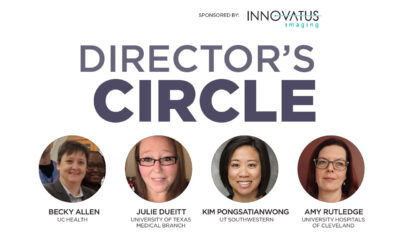
By Beth A. Allen
 As artificial intelligence (AI) has emerged and will progress to make image production and interpretation more standardized and efficient, I would like to make a point regarding the emotional intelligence that will never be replaced by a computer.
As artificial intelligence (AI) has emerged and will progress to make image production and interpretation more standardized and efficient, I would like to make a point regarding the emotional intelligence that will never be replaced by a computer.
Over the years, I have experienced situations as well as heard from many others, where intuition tells you to question the facts or do something more than is normally required.
As humans, we can pick up on verbal or physical cues that help us assess the situation. Many patients come into our medical imaging department not really understanding why they are there or what test they are going to have done. They have given a brief description of their condition to their ordering provider, which was then entered into a tablet for the EMR. Often symptoms are selected from a drop-down menu to save time. While in the office with their physician, they can be intimidated and forget some key information that would have been helpful to know when deciding on what imaging would be beneficial.
Once these patients get into the room with a technologist, they may remember a detail or two that may make a difference in their diagnosis. They may share something with the ultrasound tech that helps direct the imaging that is performed. They may state they thought they were also supposed to have another exam that had not been scheduled. There may be a mention of a prior surgery or procedure that will make a difference in the protocol that is used. It may just be a look in their eyes or a twinge when touched that will tell a tech that the pain may be more severe than the patient wants to admit.
There is still an art to radiology.
AI has come a long way. Deep machine learning will continue to help us be efficient in our workflows, protocols and equipment issues. It is still, and will always be, important that we, as professionals, are paying attention to the information we have when we begin the study; what we learn while completing the study; and what we know after the study.
Does the script give all the information we need? Is it accurate? Does it gel with what the patient is telling us? Does it seem that what is ordered is appropriate? To take a couple of moments to make sure that we are connecting with our patient and listening to what they have to say will truly make a difference in their care. It is not all plug and play – a flow chart if you will. Each patient is unique and while we have done this same exam 1,000 times, it may not ever have been done for them.
I am not implying that techs should be questioning an ordering provider. It just makes sense to pay attention to our part of the process and be on the look out for errors. The difference between a sentinel event and a “good catch” may be just one more human taking an extra second to verify the details.
Patients need us to keep the human element in radiology. We have big equipment, fancy computers and technology that has replaced the “index card” radiology record that we had at my first job. Maybe something tells you to hold this patient until you can have a radiologist look at the images. Maybe you look through the clinical notes to determine if the correct protocol was ordered. Maybe you just listen to a patient to ensure they feel heard and taken care of. Maybe it is something you see on an image, that moves you to call the radiologist directly regarding an unexpected finding. These are things that make medical imaging a rewarding career.
Don’t let technology or “going through the motions” steal the humanity and creativity that has always been the appeal of medical imaging for me. The human connection, the critical thinking/problem solving and pride you feel when you know you have made a difference for someone cannot be replaced by a computer.
I love all the ways that we have advanced and I am fascinated by the possibilities to come. I am intrigued by how the technology works, and I have always loved to learn new things.
I love people more.
Be the difference.
Thanks for all you do.








